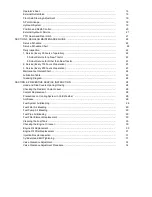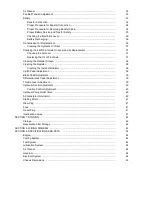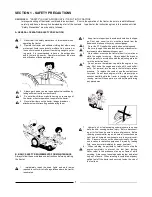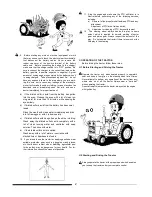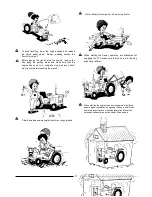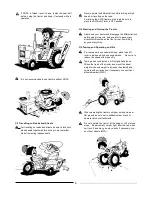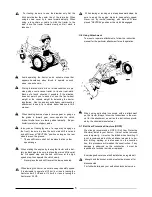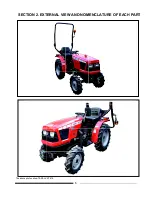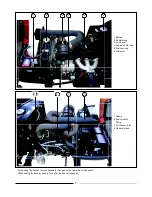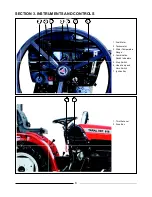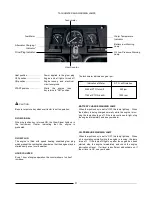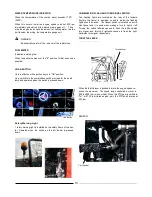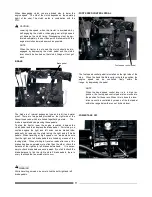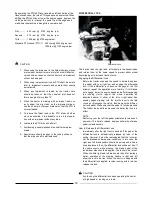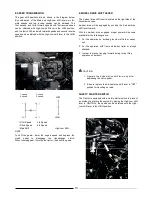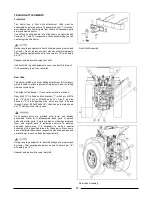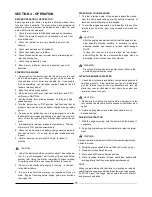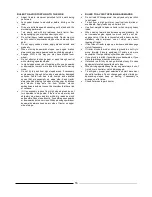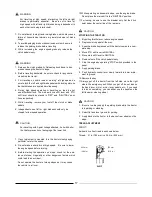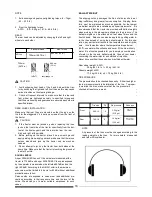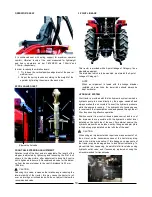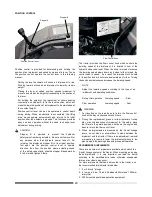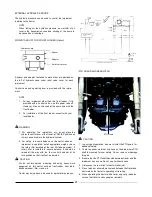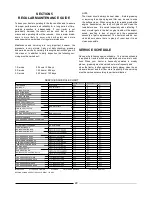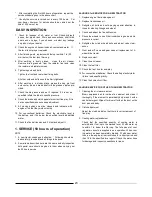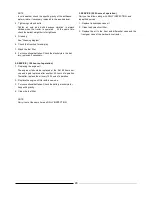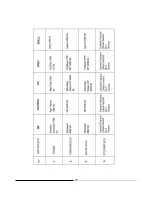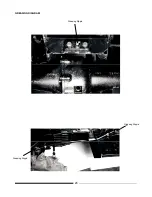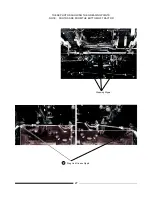
By operating the PTO shift lever located on left hand side of the
transmission case, the three PTO speeds can be selected.
When
shifting
the PTO shift lever, lower the engine speed
,
depress the
clutch pedal fully to interrupt the power from the
engine and
make sure the machine is brought to a complete halt.
First
..........
623 rpm @ 2700 engine rpm
Second
....
919 rpm @ 2700 engine rpm
Third
........
1506 rpm @ 2700 engine rpm
Standard PTO speed (PTO-1)
540 rpm @ 2340 engine rpm
1000 rpm @ 1793 engine rpm
DIFFERENTIAL
LOCK
CAUTION
Differential Lock
1.
When
using the implement in the field with many
stones
or stumps or hard soil, where a lot of shock will
affect on,
care should be taken so that the tractor and
implement
will not be damaged.
2.
When using implements driven by PTO shaft, be sure
to
refer to implement manuals and operate them
exactly
as instructed.
3.
When any implement is towed by the tractor, care
should be taken so that the universal joint does not
form an angle of more than 15°.
4.
When the tractor is working with an impact load, cor-
rectly adjust the slip clutch on the implement side or
use the shear pin of proper material so that the PTO
is
not overloaded.
5.
To reduce the thrust load to the PTO driven shaft as
much as possible, it is advisable to run a test opera-
tion with an implement without any load.
6. Lubricate the PTO driven shaft well.
7.
Avoid using a square-shaped drive shaft where prac-
ticable.
8.
Special care should be given to the yoke position so
that the driven shaft is well balanced.
This device links the right and left wheels in the transmission
and rotates them at the same speed to prevent either wheel
from slipping or to increase traction force.
Engaging the Differential Lock
Before the tractor slips and the speed is lowered, depress
the pedal with your right foot and engage the differential
lock. If the differential lock does not engage at the first
attempt, repeat the operation more forcibly. If it still does
not engage, lower the engine speed and after disengaging
the
running clutch, repeat the whole operation as
described above. If either of the left or right wheel has
already begun slipping, turn the throttle lever to the idle
running or disengage the clutch, then depress the differen-
tial lock pedal. Make sure that the pedal is fully depressed.
The further the pedal is depressed, the better the lock is in
effect.
NOTE
Removing your foot off the pedal automatically releases it,
however if it is hard to release, depress either side of brake
pedal instantaneously.
How to Release the Differential Lock
Immediately after the right foot is moved off the pedal, the
differential lock is automatically released by force of the
spring. However, it must be remembered that the lock may
not be released under special conditions. In this case, the
right and left brake pedals should be quickly and alterna-
tively depressed, then, the differential lock will be set free.
If
the same occurs while plowing, the brake pedal of the
land wheel side should be applied.
The lock will be let out.
When the both right and left brakes are linked for towing a
trailer, operation of the steering handle to right and left
allow the lock to be free. When the tractor is stopped with
the differential lock applied, reverse running with a jerk can
release the lock.
CAUTION
Avoid using the differential lock when operating the tractor
at high speed or running on a road.
12
Summary of Contents for VST 818
Page 2: ......
Page 16: ...SECTION 2 EXTERNAL VIEW AND NOMENCLATURE OF EACH PART The above photos show TARAL VST 818 6 ...
Page 35: ...25 ...
Page 36: ...GREASING DIAGRAM Greasing Nipple Greasing Nipple Greasing Nipple 26 ...
Page 45: ...PROPER BATTERY MAINTENANCE AND TIPS FOR SAFETY 35 ...
Page 53: ...SECTION 8 WIRING DIAGRAM 43 ...
Page 58: ......
Page 59: ......

